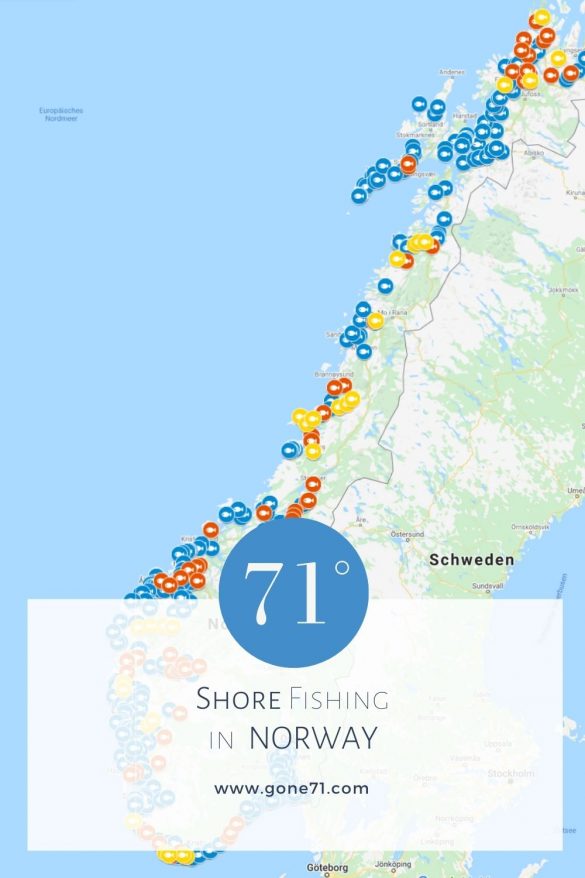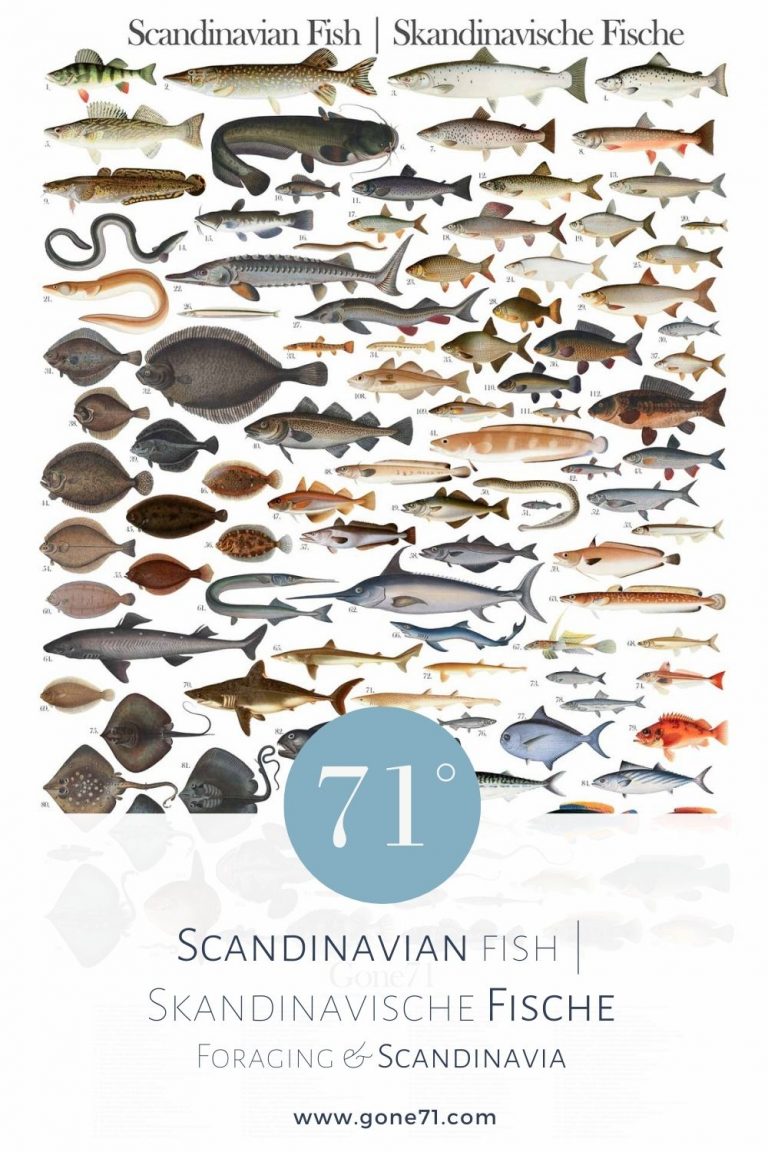Every fishing enthusiast has probably heard of the incredible fishing grounds in Norway – giants, endless possibilities and fish everywhere. Norway is a true paradise when it comes to fishing and everyone who comes here has to choose as to what they actually want to catch and to prepare accordingly. Most travelers do not have the opportunity to bring their own boat to Norway and chartering one is often very expensive or not possible at all. Especially if you are traveling through the country with a camper or mobile home, the best way to get fresh fish is to stop off at one of the countless fjords in Norway and try some shore fishing.
Fishing in Norway
Before you get started, there are a few things to consider. As in most countries, Norway requires special permits to fish in fresh water. So if you want to mainly hunt for salmon, trout, grayling and char, you have to follow the corresponding rules and pay license fees to fish the rivers and lakes.
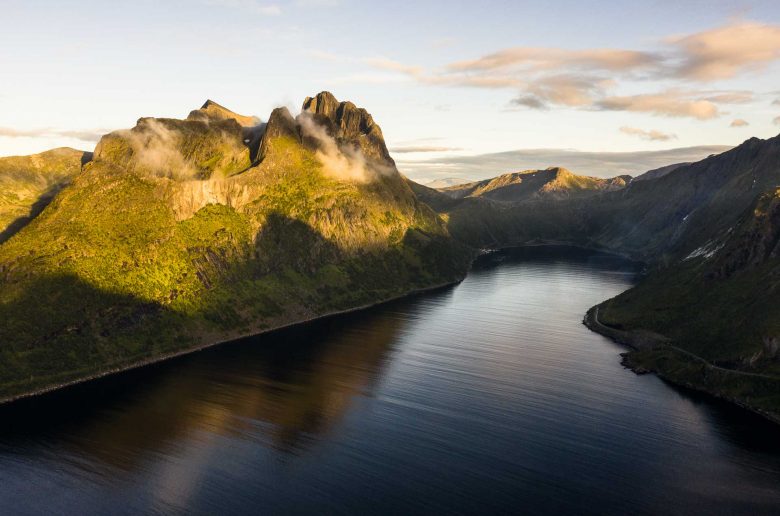
Fishing in the sea
The really good news is that fishing at sea is generally allowed for everyone and no permits are required. The even better news is that Norway has a truly incredible coastline stretching more than 2500 km north. If you add up all the sections along the fjords and bays, there is even more than 28,000 km of coastline that can be fished on the whole – and the shores of the approx. 240,000 islands are not even included here. For fishing opporunities probably more than is probably possible in a lifetime.
There is fish for everyone here and yet the hunt for the slippery sea creatures is not always easy. Not every spot is equally suitable and fish stocks and species vary from region to region. Anyone who is already satisfied with mackerel or smaller pollocks and coalfish has an easy job in most cases. At some spots, simply throwing the lure into the water is enough to be rewarded with a suitable dinner fish.
In other areas things can get tricky and without the right approach you can spend hours on the water and end up empty-handed. Choosing the right spot is in this regard often more important than choosing the right lure. Many good fishing spots are often a well-kept secret, but with a little knowledge, research and a satellite map you can also identify excellent spots in your area yourself.
Norwegian shorefishing is still in its infancy. Over the last few years, however, the demand for targeted shorefishing adventures has increased rapidly and there are already a number of providers who have specialized in guiding customers to specific marks and providing them with insider information. Giant cod, coalfish, plaice, wolffish, ling, or even a halibut await usually as a reward. However, such offers are not for everyone and many simply want to go out on their own and try their luck.
Shore fishing spots (map)
Since we ourselves spend every year in the far north hunting for excellent fish, we have summarized the information and research that we have collected over the years in a map. The map includes hundreds of spots that have been fished by us or other enthusiastic fishermen. It goes without saying that with almost 30,000 km of coastline, the sheer attempt to capture relevant spots remains a drop in the bucket. And yet it is often very helpful when travelling through an unfamiliar area to get an idea of where other fishermen have already successfully hunted. Especially if you are interested in more demanding fish species such as sea trout, halibut or salmon, any clue that can lead to success is usually welcome.
If you don’t have the possibility to draw on local knowledge, this map is a good starting point from which you can plan your projects further. That doesn’t mean you should get lazy. Definitely do your own research in addition. The Spots usually say nothing about the season or the time of day. Some areas fish better when the water is rising, others when it is receding or in the transition periods. Some marks are only good in winter, others in summer.
In addition to general fishing marks (blue), the map also shows specially designated spots (red) and areas (yellow) for salmonids such as sea trout, salmon or char. These fish are at the top of the list for many anglers and if you don’t want to afford the often very high license fees or are only staying in one place for a short time, then such spots can be an interesting alternative.
We plan to actively manage this map and update it dynamically with new spots. If you want to share some insigths in your experiences let us know and we will be happy to include them.
Promising Areas
Whilst there is a fish to be found around almost every corner, some areas are of course particularly well known for their plentiful fish stocks. Saltstraumen’s famous malstrøm is known for its large cod, coalfish and halibut.
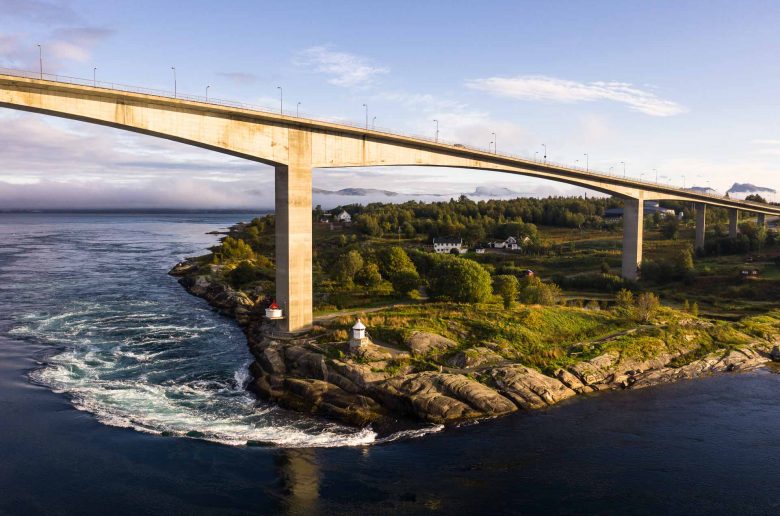
The Lofoten are famous for their big cod (skrei) The. South and West Coast of Norway are great areas to hunt for sea trout. From the Trondheim area through Lofoten and especially in the Troms region you can take on sizeable halibut if you are lucky. But also other well-known marks like Hella at Rystraumen near Tromsø, the Kvalsund Bridge in front of Hammerfest or the many great spots along the Trondheimfjord and the Skarnsundet Bridge. Mackrele are found in large numbers, especially in southern Norway. Those who like it exotic can try one of the numerous wrasse species that are widespread along the Oslofjord and on the south coast.
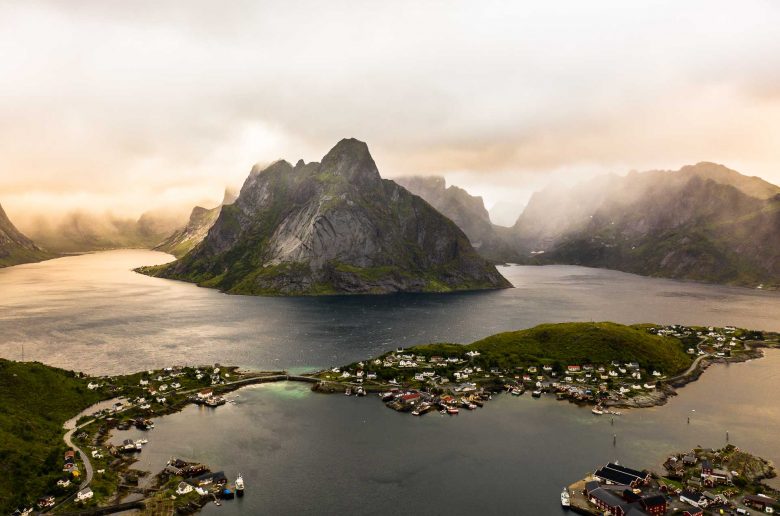
Identifying a good mark
In order to identify a good fishing spot, you must first of all know which target fish you have in mind. For mackerel, small pollocks or smaller cod it is often enough to go to the nearest pier or dock or simply try your luck from the next rock on the shore. However, if you want to try your hand at larger fish or special species such as sea trout or flatfish you have to approach things in a more differentiated way.
Sea trout can often be found in shallow waters near estuaries. Be aware that there is a rule that you have to be at least 100 meter away from where a river enters the sea.
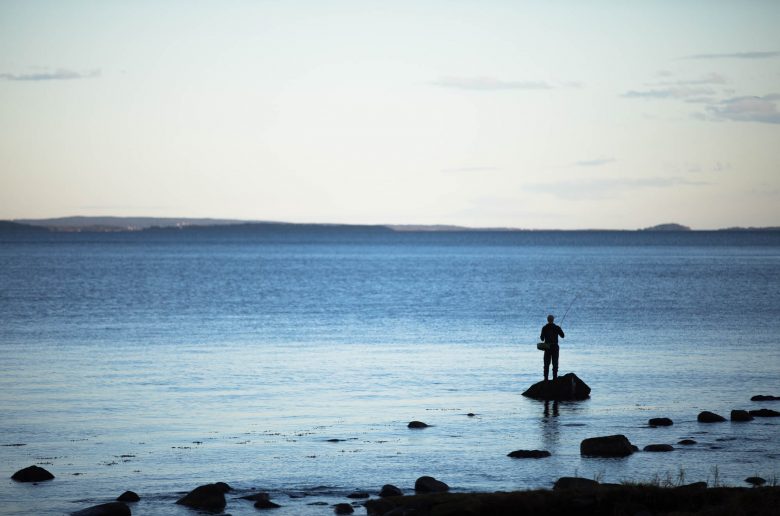
For larger cod or even halibut usually goes the deeper the better. Moles, docks or ferry terminals are therefore often a good starting point in a new region because the water depths are somewhat deeper there in comparison to the sourounding options. Flatfish such as plaice or dab are mainly found on sandy bottoms.
Straumen
Very good marks are usually so called “Straumen”. These are mostly straits where a relatively large amount of water has to flow through a narrow channel between the tides and which usually have a very strong current. Some fjords are only connected to the sea by very narrow straits and all fish that want to enter the inner parts of the fjord in search of food must first pass through here. In some cases they can be only a few meters wide, in others they are like large rivers that regularly change their flow direction. Smaller straumen in particular are often good spots for sea trout and even salmons, but also for pollock, coalfish, cod and even halibuts. The most famous Straumen in this respect is Saltstraumen near Bodø. Record-sized cod, coalfish and halibut are caught from the shore here every year.
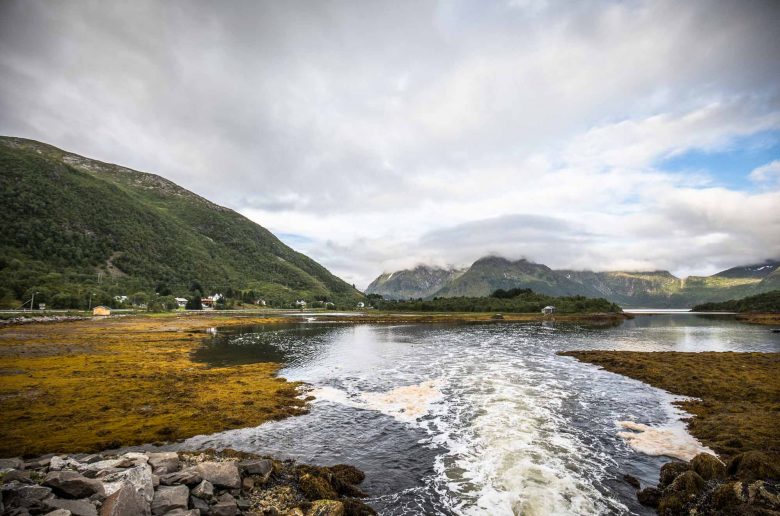
Nautical chart
If you want to do your own research the nautical chart is a very good instrument to get a good estimate of the water depth for the areas you are looking for. The map is in Swedish but self explanatory –> Nautical Map
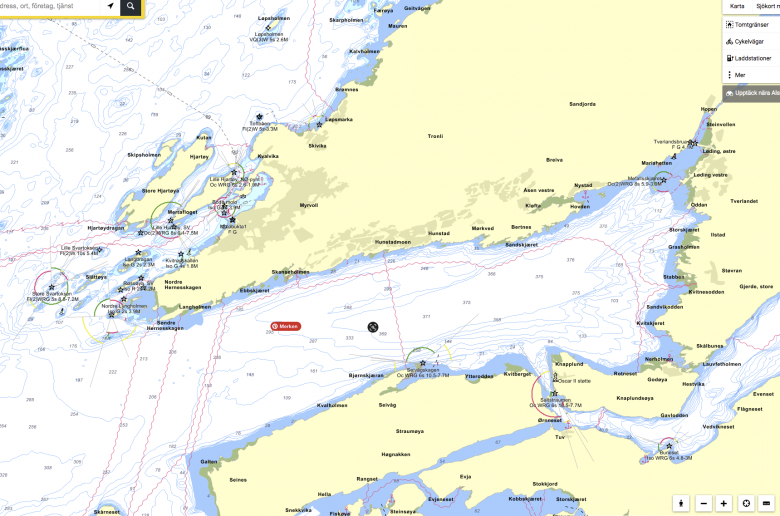
Timing
No matter how promising a fishing spot may appear. If you are there at the wrong time of day or season, you can end up empty handed. Some of the largest fish are typically caught during the winter months when many fish are closer to shore to hunt or breed. So if you are shore fishing in Norway during summer, you should be aware that some of the famous spots as Saltstraumen or Lofoten produce the best catches at completely different times of the year.
Timing and preperation is key
The problem with new spots is usually that without prior information, you have no idea which times are most suitable. Local knowledge is gold in this regard so don’t be shy to ask around. You could find yourself in a unique spot without knowing it’s an ebb mark while you’ve been there for 6 hours without a bite. If you want to try new or unfished spots, there is no way around doing some pioneering work and investing time. Depth charts and satellite images can of course be extremely helpful. But also secondary details, such as where you can park your car or knowing how (difficult) the access to a spot is, can save you a lot of time and trouble on site.
Fishing equipment
Shore fishing is still in its infancy in Norway. Fishing at sea is mostly done from a boat, and fishing from the shore in the fjords has only really taken off in recent years. Of course, there are different approaches here as well. For seasoned fishermen, shore fishing usually means laying out bait with heavy tackle and a surf rod. This approach is particularly effective when hunting for large cod or halibut, but also for dabs, plaice or wolffish and ling. Unfortunately, this not only requires extensive knowledge, but also heavy and not necessarily handy equipment. This access is not very suitable for a spontaneous fishing trip. The other and much more common approach is spin fishing with classic pirks, rubber sheds and similar lures. This method is very active fishing and depending on your own goals, success can be achieved quite quickly.
Equipment spin fishing
Our all-round spin fishing equipment for Norway consists of a 2.70 m rod with a casting weight of around 50 to 100 grams. For the reel we use a size 4000 equipped with an 8-strand braided line of around 0.2 and a 0.8 monofil shock leader. [If these numbers do not tell you anything look here]
Of course, what you actually need depends on your sitiation, but for us this equipment covers 90 percent of all applications very well. Even a surprising halibut, large cod or salmon can be landed with it. It is for sure on the excessive end of the spectrum for a simple mackerel or a tender sea trout. For the latter, we usually have a lighter rod in the bag, but this is rarely used and if we would have to choose the bespoken equipment woud be our weapon of choice. We like to be prepared for most situations while venturing fishing onto the shore in Norway.
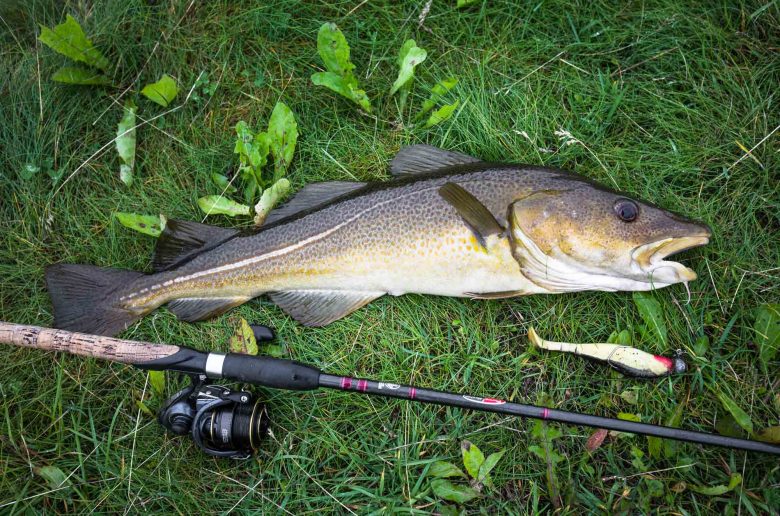
Equipment bait fishing
Anyone who comes to Norway specifically for bait fishing will usually prepare well in advance. As a rule, much longer rods in the 4 meter segment are used here in order to get the bait out as far as possible. Since you often fish for big fish, the spool and line should be dimensioned accordingly. For example, standard pulley rigs with 6/0 to 8/0 hooks and 0.8 to 1mm (~40kg/90lb) rig body are great for big cod and halibut. If you are only fishing for plaice or flounder, you can of course confidently choose a much lighter setup.
Bait are generally found in abundance everywhere. In addition to mussel, clam or lugworm, which you can look for yourself in many bays, herring or mackerel are particularly suitable as bait. But shrimp or squid are also good in many situations.
Common species and tactics
nor.: torsk, swe.: torsk; fin.: turska; dt.: Dorsch
Best times for fishing big specimen of cod (Gardus morhu) is March to April when the weather gets calmer and large schools of cod can be found on the outer coastline of Norway. That said, smaller but still decend-sized specimen can be caught whole year round.
When fishing inshore look out for areas with dense rocks, cliffs or even some kelp with good hiding places. When it comes to jig- and bait size, bigger is definitely better. Cod hunt close to the bottom and heavy jigs definitely help to get your lure down to these depths. When fishing with bait, hering or makarel are a good way to go. However, shrimp, squid or mussels are great too but make sure to use enough or otherwise you’ll end up with small specimen.
nor.: sei; swe.: gråsej; fin.: seiti; dt.: Köhler
This salt-water fish is in the same family as cod and can be easily caught from the shore in the coastal areas especially further north. Coal fish (Pollachius virens) is a powerful swimmer and it navigates even the strongest current in Norway, the Saltstraumen maelstrom. It’s also there where you can find this fish – big in numbers and size. Saithe feed on herring, sprat, krill and almost everything else that has the right size and moves through the water. Unlike their bottom dwelling relatives the cods, they hunt closer to the surface and you will find it much easier to catch one of these.
nor.: kveite, hälleflyndre; swe.: hälleflundra; fin.: ruijanpallas; dt.: Heilbutt
For many, halibut (Hippoglossinae) is the true king of fish. These fish can weigh over 200kg and grow to gigantic proportions. However, if you want to catch a halibut from the shore, you need a good portion of luck as well as some know-how. A good area to target these powerhouses is the Troms region, various areas of Lofoten or Saltstraumen. Halibut are known to enjoy spending time in channels between islands.
nor.: Makrell; swe.: Makrill; fin.: Makrilli; dt.: Makrele
Mackerel (Scomber scombrus) is a pelagic fish that is very common in the North Atlantic and along the Norwegian coast. It has a characteristic appearance with black stripes along the body side, and is among the most famous fish in southern Norway. Fishing for mackerel takes place mainly in the summer when they arrive in big numbers close to the shores. These fish have a very muscular body and put up a big fight. You can often encounter them trailing swarms of herring. Mackerel are not very picky when it comes to feeding behaviours and most lures with a fast action work in our experience. Traditionally mackerel are usually fished with “pilks” or “pirks” but spoons, jigs or even spinners might do the job as well. When fishing from shore, try to real in fast and steady.
nor.: rødspette; swe.: rödspätta; fin.: punakampela; dt.: Scholle
Plaice and other flatfish can be found along the coast of all of Norway. They prefer sandy soil. Sandy bays and peers in sandy areas are therefore good places to go. Lugworms are a particularly good bait here. In many cases, you can look for these yourself on the spot. But shredded mackerel or herring, squid or shrimp are also very suitable.
nor.: lyr; swe.: lyrtorsk; fin.: lyyraturska; dt.: Steinköhler, Pollack
Pollack (Pollachius pollachius) is member of the cod family and often confused with its close relative, the coalfish (Pollachius virens). Specimen usualy grow to around 60-70 cm but can occasionally reach length up to 130 cm. Similar to coalfish, pollock can endure strong currents and set up a strong fight. When it comes to fishing, the general rule of thumb is the further north the better and bigger the pollack. Direct exposure to the Atlantic ocean is key for big specimen. If you are fishing from shore make sure to find a spot with a decent depth. Moles, Ferry piers or fishing from cliffs can produce very good results.
nor.: laks; swe.: lax; fin.: lohi, dt.: Lachs
Salmon (Salmo salar) are not exactly the classic fish that are caught from the shore at sea. And yet, with a bit of know-how and luck, you can fish for these coveted fish. These fish can be specifically targeted at small straumen or at peers and breakwaters in the immediate vicinity of salmon rivers. Especially in the warmer months when the salmon are migrating along the coast at the estuaries, there are often opportunities to catch these majestic fish. However, it is important to make sure that you find out beforehand how far from the river mouth you can fish.
nor.: sjøørret; swe.: havsöring; fin.: meritaimen; dt.: Meerforelle
Sea trout (Salmo trutta trutta) is one of the very popular target fish in Norway. This migratory species of brown trout is found along the entire coast of Norway and can grow to impressive sizes. However, it is not necessarily easy to actually catch these animals. Sea trout are known to be very picky when it comes to feeding.
Be also aware that there is a minimum size ( usually around 35cm) required in order to keep your catch. Otherwise you have to carefully release it.
Sea trouts up to 4 kg are considered a normal catch in certain parts and they can grow even bigger. They are a great game for spin fishing and fly fishing.
nor.: gråsteinbit; swe.: havskatt; fin.: merikissa; dt.: Seewolf, Steinbeißer
With their striking appearance, wolffish (Anarhichas lupus) are not exactly the most beautiful of sea creatures. In the kitchen, however, it is highly valued by many fish. This fish’s favorite food is mussels, which it grinds up with its powerful jaws. Wolffish are often caught as by-catch when fishing for cod or halibut. If you want to target these animals, it is best to use mussels, rekers or squid as bait. Since these animals feed on mussels, they are often found in shallower waters near mussel beds. You can also actively target them with lures on the bottom. Since wolffish do not directly feed on fish you should consider using artificial lures that do not mimic small fish.
Cod
Gardus Morhua
Coalfish
Pollachius virens
Pollock
Pollachius pollachius
Mackerel
Scomber scombrus
Sea trout
Salmo trutta trutta
Salmon
Salmo salar
Illustration of Scandinavian fish
We have also created this overview of Scandinavian fish. Find more details here.
Rules and regulations
The realy great thing in Norway is that you don’t need a license for shore fishing at the coast or even deep sea fishing from a boat in Norway. However, there are some important rules that must be observed.
- 1) Respect the minimum fish size. [see table below]
- 2) Handheld tackle only
- 3) Keep a minimum distance of 100 meters from the closest fish farm
- 4) If not specified otherwise, keep a minimum distance of at least a hundred meters where a river flows into the sea.
- 5) It is forbidden to fish for cod in Oslofjord all year round.
- 6) It’s illegal to sell your catch
- 7) If you want to export fish from Norway you have to fish with a registered fishing camp. The export quota is 15kg of fish (products), applicable twice per year
If you are on the hunt for freshwater fishes like trout, greyling, char or salmon in one of the prestine Norwegian rivers or lakes you have to be aware that there are totally different rules and regulations that apply. Disregarding these can get very expensive in Norway, so do your research first.
Species | Minimum size North of 62°N | Minimum size South of 62°N |
cod | 44 cm | 40 cm |
halibut | 80 cm | 80 cm |
redfish | 32 cm | 32 cm |
wolffish | no minimum size | no minimum size |
saithe | no minimum size | no minimum size |
haddock | 40 cm | 31 cm |
whiting | 32 cm | 32 cm |
hake | 30 cm | 30 cm |
mare flounder | 28 cm | 28 cm |
dab | 23 cm | 23 cm |
lemon sole | 25 cm | 25 cm |
sole | 24 cm | 24 cm |
turbot | 30 cm | 30 cm |
brill | 30 cm | 30 cm |
megrim | 25 cm | 25 cm |
European flounder | 20 cm | 20 cm |
European eel | 40 cm | 40 cm |
silver eel | 37 cm | 37 cm |
dogfish | 70 cm | 70 cm |
Greenland halibut | 45 cm | 45 cm |
mackerell | no minimum size | no minimum size |
North Sea herring | no minimum size | 20 cm |
herring (Trondheimsfjorden) | 23 cm | 23 cm |
wrasse (except ballan wrasse and corcwing wrasse) | 11 cm | 11 cm |
corkwing wrasse | 12 cm | 12 cm |
ballan wrasse | 14 cm | 14 cm |
sandeel | 10 cm | 10 cm |
Norway lobster | 13 cm | 13 cm |
European lobster | 25 cm | 25 cm |
great scallop | 10 cm | 10 cm |
The measurement for fish is from the tip of the snout to the end of the outermost rays of the groove. For lobsters you have to measure from the tip of the forehead horn to the back of the middle swim tab.
If you want to share your experiences or know about other places let us know in the comments or in a DM.
